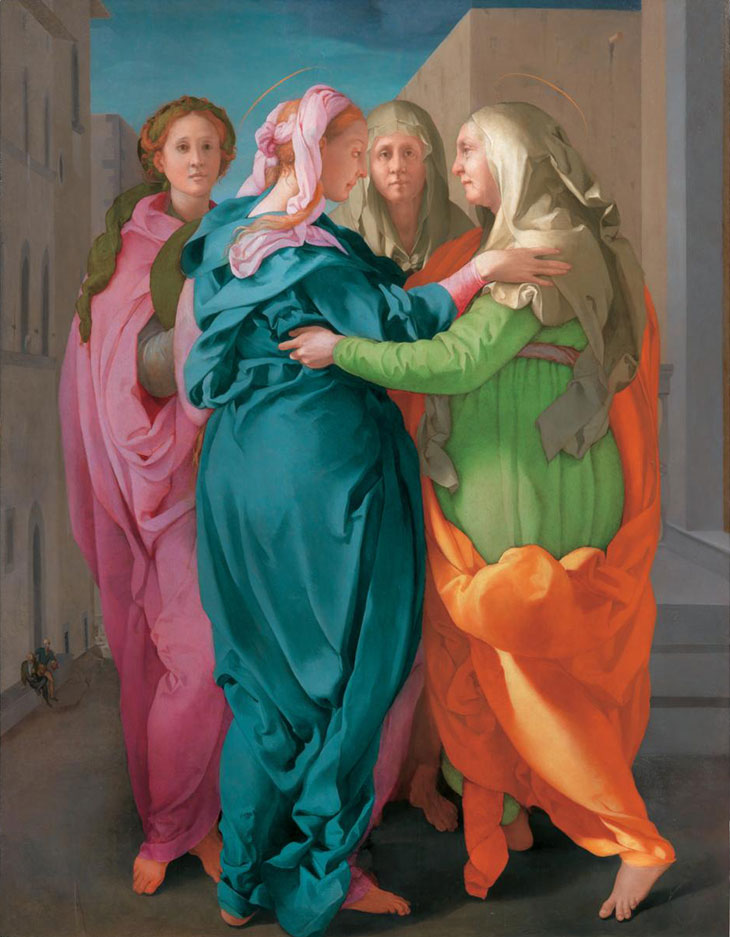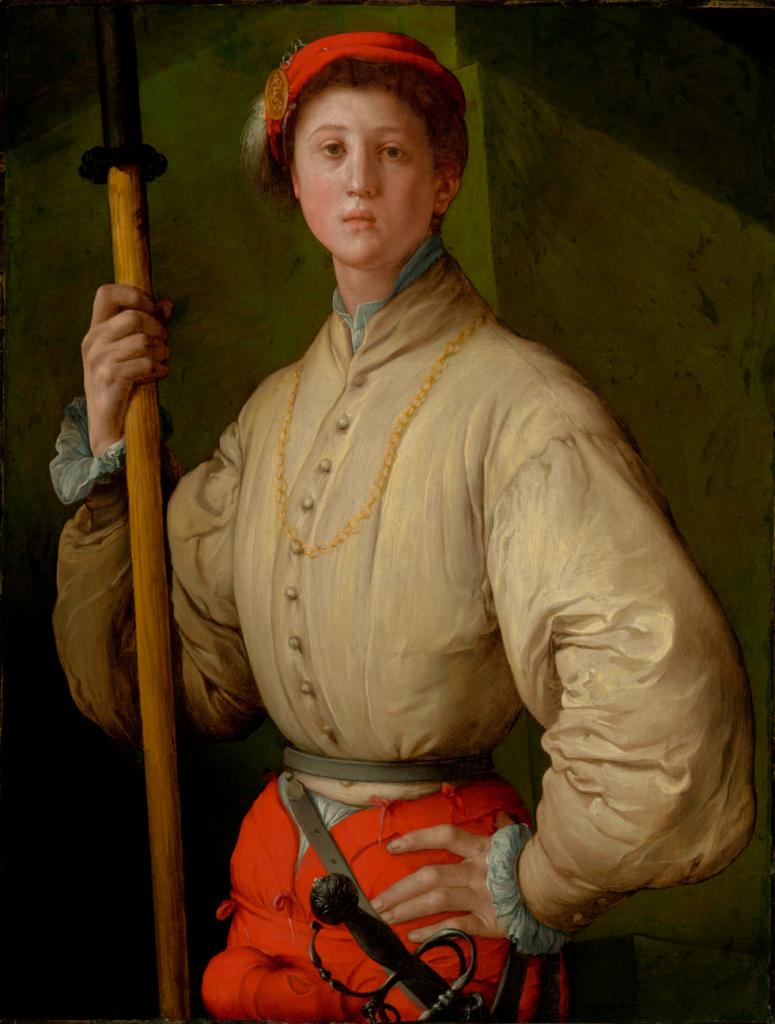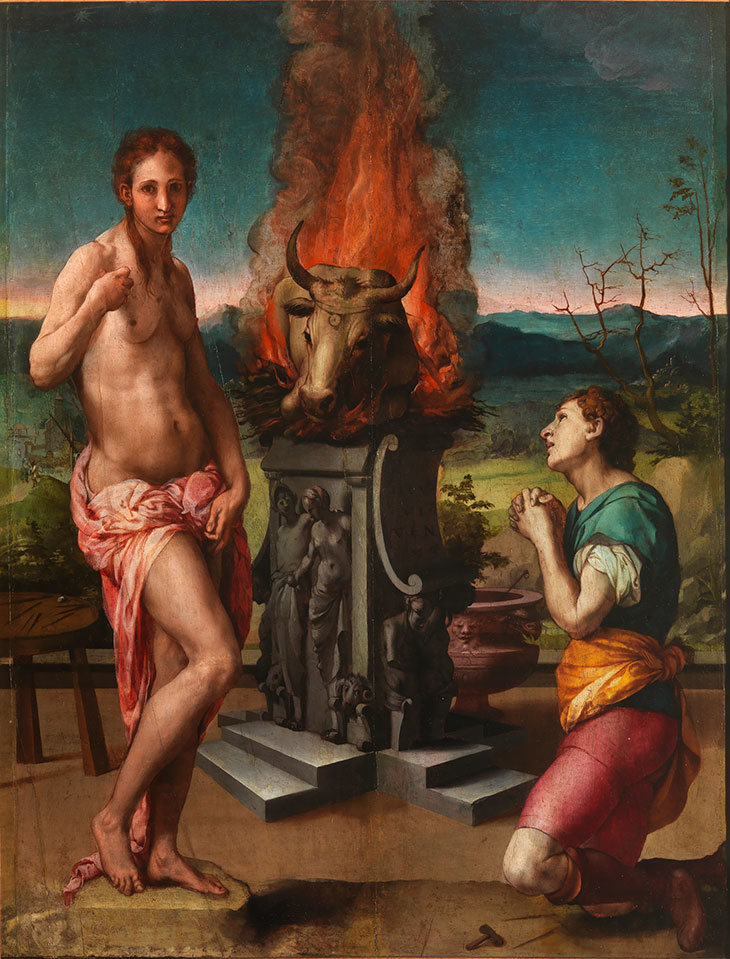‘One of the most enigmatically beautiful paintings of 16th century Italy […] once seen, [it] will never be forgotten,’ writes Getty Museum director Timothy Potts of Pontormo’s two-metre-high painting, the Visitation. The work, the centrepiece of a display currently on view at the Getty, celebrates the encounter of the Virgin Mary with her much older cousin, Saint Elizabeth, when both are miraculously carrying holy infants – Jesus and John the Baptist, respectively. As described in the Gospel of St Luke, the cousins met in the city of Judah, but Pontormo has set the scene in his own Tuscan environment, when Republican Florence was under siege in 1528–29. Two tiny figures in the distance to the left of the central group may represent Joseph and Zechariah, their husbands. A donkey, the transport associated with Virgin Mary, lurks round the corner; it was recently uncovered, during restoration.
Visitation (c. 1520), Jacopo Carucci, known as Pontormo. Parish of San Michele Arcangelo in Carmignano. Photo: © Antonio Quattrone, Florence

The painting, which is unframed, creates a spellbinding encounter for the visitor. The psychological engagement of the two holy women who face and embrace each other is heightened by the intense saturated colours of their garments: azurite blue for Mary and malachite green with an orange ochre cloak for Elizabeth. Profound joy shines out of Saint Elizabeth’s mature face as she greets her younger cousin, while John the Baptist stirs in his mother’s womb on recognising the unborn presence of the Christ Child. The spectator is drawn into the composition by two handmaidens facing out behind the main protagonists. A Florentine visual tradition dictated that proper women should not appear in city streets unattended. A precedent for this interpretation is the 13th-century mosaic in Florence Baptistery dedicated to the city’s patron saint, John the Baptist.
The use of vibrant colour was, it has been suggested, facilitated by the original patron, Bonaccorso Pinadori of Carmignano, a village outside Florence, where the painting became by 1720 an altarpiece within the local church, Santi Michele e Francesco. Pinadori, a merchant who regularly sold artists’ supplies to Pontormo and his pupil and associate Bronzino, supplied the paintbrushes and pigments. This was an effective advertisement but the colours are also symbolic, heavenly blue for the Virgin and green, the colour of hope, for Elizabeth. Their meeting is projected into the spectator space in imitation of Roman relief sculpture of marital scenes. The Visitation also recalls Dürer’s print Four Naked Women (1471), displayed nearby; Vasari noted that Pontormo and other Florentine artists ‘were all proclaiming with one voice […] the beauty of those engravings and the excellence of Albrecht’ when Dürer’s prints circulated during the 1520s.
Portrait of a Halberdier (Francesco Guardi?) (1528–30), Jacopo Carucci, known as Pontormo. The J. Paul Getty Museum, Los Angeles

The display, which was shown first in Florence at the Pitti and then in New York at the Morgan Library, also provides the opportunity to reassess the Visitation alongside Pontormo’s final study for the composition, squared for transfer, and his Portrait of a Halberdier identified as the youthful Francesco Guardi (1514–54) although acquired by the Getty as Cosimo I de’ Medici in 1989. Adjacent to this hangs the portrait’s ‘cover’, painted by Agnolo Bronzino, who joined the master’s workshop 12 years earlier. Paintings and mirrors sometimes had covers although very few survive; they were not just for protection for they could provide commentary on what they concealed.
Pygmalion and Galatea (1529–32), Agnolo Bronzino. Uffizi Gallery, Florence. Courtesy the ministry of culture and tourism, Florence and the Uffizi Gallery

Vasari noted the subject here was Pygmalion appealing to Venus to endow the ivory statue he had created with the spirit of life, as narrated by Ovid in Metamorphoses. Pygmalion kneels in the position adopted by Pontormo for the figure of St Francis in the altarpiece commissioned by Francesco Pucci for his family’s funerary chapel in San Michele Visdomini in Florence in 1518. The quotation is appropriate here as the figure covers the portrait of another Francesco. As the subject of Pontormo’s portrait was republican, there may have been a political necessity to conceal it after the Medici return to power in 1530. The rural idyll to the left background of the vitalised statue shows a church on a hill, a well and a wattle fence, with a man and woman returning to the city with provisions from the country, reflecting the joys of peace.
Portrait of a Man (Carlo Neroni) (1529–30), Jacopo Carucci, known as Pontormo. Photo: courtesy Shepherd Conservation, London

The Portrait of a Young Man in a Red Cap, rediscovered by Francis Russell from the collection of the Earl of Caledon in 2008 and identified convincingly as the Florentine nobleman Carlo Neroni is attributed in the exhibition to Pontormo and provisionally dated to around 1530. At the international Pontormo conference held in Los Angeles last month, Julia Siemon proposed that the portrait could mark Neroni’s second marriage in 1540, as he wears a finger ring and holds a note that may refer to that event. The portrait may in fact have been completed by Bronzino, as the rendering of the texture of his clothes is closer to that of Bronzino’s documented mature portraits than Pontormo’s; the possibility was much debated at the conference. This small exhibition provides a wonderful opportunity to compare the techniques of these two outstanding Renaissance artists and to assess the condition and subsequent treatment of their works.
Tessa Murdoch is the 2019 Getty Rothschild Fellow.
‘Pontormo: Miraculous Encounters’ is at the Getty Center, Los Angeles until 28 April.



